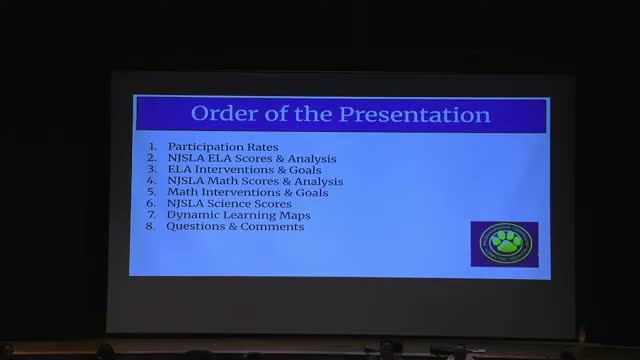Pequannock administrators present NJSLA/DLM results: ELA strong, math modeling/reasoning flagged for support
October 28, 2025 | Pequannock Township School District, School Districts, New Jersey
This article was created by AI summarizing key points discussed. AI makes mistakes, so for full details and context, please refer to the video of the full meeting. Please report any errors so we can fix them. Report an error »

District administrators presented detailed results from the 2024–25 New Jersey Student Learning Assessments (NJSLA) and the Dynamic Learning Maps (DLM) at the Oct. 27 board meeting, reporting that ELA proficiency and several cohort trends exceeded state averages while calling out gaps in math modeling and reasoning.
Dr. Portis (presentation lead) said the district had "73.6 of students score in the 4 or 5 level" on ELA statewide tests and that district average scores exceed state averages. She told the board the district is focusing on craft, structure and writing, and noted K–3 reading curriculum changes implemented over the summer, including Heggerty phonemic awareness and DIBELS progress monitoring.
Portis and other presenters described cohort tracking that follows the same students across years rather than comparing different cohorts in the same grade. They said some cohorts showed substantial gains (for example, 6→7 and 7→8 increases on deeper task items) while the same cohort’s performance sometimes dipped from grade 8 into grade 9 on certain tasks.
On math, presenters reported overall district proficiency "about 60–66%" and said district average scores were roughly 19 percentage points higher than the state average. They identified modeling and reasoning as a focal weakness — a domain the presenters described as comprising about 40% of the math assessment — and said only a small share of ninth graders achieved the high‑cut scores in that domain. To address gaps, the district described curriculum revisions for grade 8, an algebra‑tutoring program after school, Title I tutors, I‑Ready diagnostics in grades 6 and 9, and additional teacher training on scaffolds and guided notes.
Science results were described as mixed but comparatively strong in some grades (presenters reported grade 5 at about 40% passing vs. a state 30% and grade 8 near double state proficiency), and the district said it will continue to refine science instruction under a new supervisor. For students with significant cognitive disabilities tested through DLM, presenters reported the district’s 15 accountable students distributed across four performance zones.
Board members pressed presenters on algebra 1 foundations and the impact of modeling/reasoning skill gaps for students progressing to algebra 2; administrators said the NJGPA and later coursework help many students meet graduation assessment requirements but acknowledged ongoing work to strengthen foundations earlier in K–12 instruction. The board asked for elementary‑school disaggregation of results; presenters said they will provide that data after checking details.
No formal action was taken; the presentation concluded with plans for continued curriculum alignment, targeted tutoring, and further data work.
Dr. Portis (presentation lead) said the district had "73.6 of students score in the 4 or 5 level" on ELA statewide tests and that district average scores exceed state averages. She told the board the district is focusing on craft, structure and writing, and noted K–3 reading curriculum changes implemented over the summer, including Heggerty phonemic awareness and DIBELS progress monitoring.
Portis and other presenters described cohort tracking that follows the same students across years rather than comparing different cohorts in the same grade. They said some cohorts showed substantial gains (for example, 6→7 and 7→8 increases on deeper task items) while the same cohort’s performance sometimes dipped from grade 8 into grade 9 on certain tasks.
On math, presenters reported overall district proficiency "about 60–66%" and said district average scores were roughly 19 percentage points higher than the state average. They identified modeling and reasoning as a focal weakness — a domain the presenters described as comprising about 40% of the math assessment — and said only a small share of ninth graders achieved the high‑cut scores in that domain. To address gaps, the district described curriculum revisions for grade 8, an algebra‑tutoring program after school, Title I tutors, I‑Ready diagnostics in grades 6 and 9, and additional teacher training on scaffolds and guided notes.
Science results were described as mixed but comparatively strong in some grades (presenters reported grade 5 at about 40% passing vs. a state 30% and grade 8 near double state proficiency), and the district said it will continue to refine science instruction under a new supervisor. For students with significant cognitive disabilities tested through DLM, presenters reported the district’s 15 accountable students distributed across four performance zones.
Board members pressed presenters on algebra 1 foundations and the impact of modeling/reasoning skill gaps for students progressing to algebra 2; administrators said the NJGPA and later coursework help many students meet graduation assessment requirements but acknowledged ongoing work to strengthen foundations earlier in K–12 instruction. The board asked for elementary‑school disaggregation of results; presenters said they will provide that data after checking details.
No formal action was taken; the presentation concluded with plans for continued curriculum alignment, targeted tutoring, and further data work.
View full meeting
This article is based on a recent meeting—watch the full video and explore the complete transcript for deeper insights into the discussion.
View full meeting
